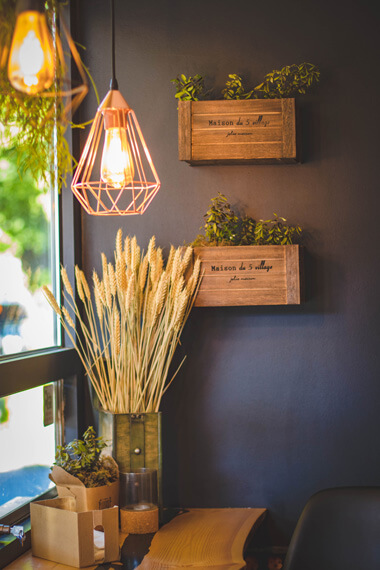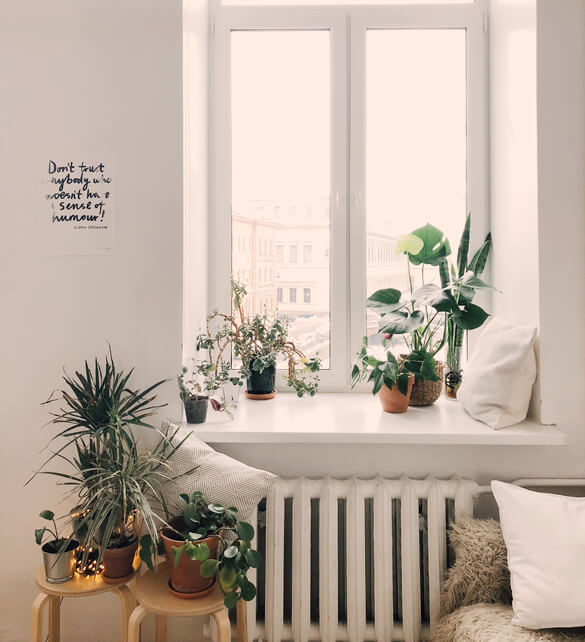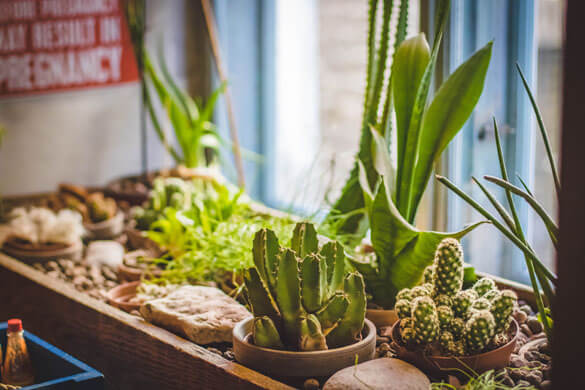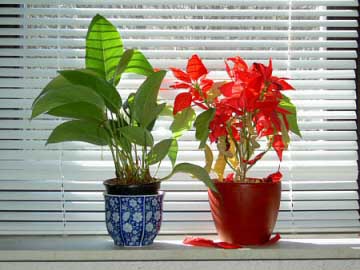Light is the fuel that powers our houseplants. It's the vital ingredient needed for photosynthesis to take place and without it, growth is limited, slow or non existent.

Photo by Valeriya
The amount of light each plant needs varies and depends on the time of the year. So where as some plants will be quite happy with semi darkness permanently, others will only accept it for a limited time. Check our plant guide if you need any help with one particular houseplant.
The type of light levels you can find in a typical home vary considerably. The below drawing gives you some idea of what you could expect to find in a typical home.
Note how the placement of windows and doors can make a huge difference. You'll need to think and observe how the sun moves around your room to work out the type of light levels you have and how that changes during the day.
Drawing by LÉON & GEORGE showing examples of the different light levels you can find in a home
(click the picture for a bigger version)
The easiest and cheapest light you can provide is the natural kind, which is achieved in most cases by simply putting the plant near a suitable window.
If you don't have much window space (potentially because you've amassed a significant number of green leaved friends), or have no choice but to pick a darker spot you can substitute natural light with artificial instead.
You probably won't get away with using a normal table lamp for this though (see our article "Do regular LED lights work for Plants" for more). If you're using artificial light you'll need a "grow light" or "plant light".
These types of lights have been designed to stimulate plant growth by emitting an electromagnetic spectrum appropriate for photosynthesis.
They're specialised however, and as well as being moderately expensive to buy they'll also be a drain on your electricity supply.
Further reading -
Use our calculator to find out what a grow light costs to run?
We think artificial lights are great on a temporary basis, for example in the Winter months when natural light is limited, but at other times of the year you should really seek natural sources wherever possible. It's free and the best quality for your plants.
The only exception to this is if you're wanting to grow plants in a windowless room on a long term basis. If this is your situation then grow lights are going to be an essential part of your growing equipment.

Hi, I'm Tom!
If you're like me and enjoy the challenge of growing houseplants and getting them to thrive, then Ourhouseplants can help. This website shares my knowledge and years of growing plants and provides (hopefully) helpful advice on properly caring for your indoor plant friends.
If you're using artificial light you can put the plant anywhere you choose. However if you're using natural light you'll need to consider placement in more detail. Let us look at this in more detail.
Firstly remember that few homes face exactly in the direction of the four points of a compass (North, East, South, West) so your aspect may have a combination, i.e. South East or North West etc. Keep this in mind when browsing the section below.
Windows which face North never get sunlight coming through them. If the window is facing North East, or North West you'll get some in the mornings / evenings especially during Summer. However even then for most of the day you'll have the typical North facing aspect.

Houseplants growing in a North Facing window. Photo By Daria Shevtsova
There isn't anything inherently wrong with a North facing aspect providing your plant doesn't demand partial or full sun as a lighting requirement.
Certain plants will absolutely thrive in this position, such as Aspidistra's, English Ivy and many orchids. North facing windows also provide the most consistent levels of light throughout the day, so if you're looking to grow begonias, or a foliage plant this could be the best spot for them.
The rooms that these windows belong to also tend to be the coldest. Without any sunlight this natural heat source is nonexistent. This goes hand in hand however, and the majority of plants that thrive in these locations also do so because it's cooler.
It's a good spot which a lot of plants will do well in, and others still, will adapt to
The Sun always rises in the East and therefore the East facing aspect gets the first weak rays of sunlight in the morning. Depending on the time of the year, direct sunlight has normally stopped shining through these windows by mid morning to midday.
East facing windows receive very good light levels and natural sources of heat without either being extreme.
Some plants which thrive in the North facing aspect may also do well here, but it's likely they'll need a little shielding, perhaps with the help of a partially closed blind. Ideal choices could be Echeveria or Jade Plants.
Don't be afraid to experiment with a East facing aspect, it's a good spot which a lot of houseplants will do well in, and others still, will adapt to.
As the Earth rotates during it's 24 hour cycle, from late morning to mid afternoon the planet becomes closest to the sun. Therefore the strongest rays from the sun flow through South facing windows during this part of the day.
Plants which demand full sun will thrive here, it provides optimum levels of light for photosynthesis, so growth can be pretty fast. Plants which prefer shady or a North facing aspect should only be put in this window during the Winter months when the sunlight is less intense.

Plants being grown in a box next to a window - Photo by Valeriya
With all this bright light comes heat and it's very easy for the area to become incredibly warm, even hot.
You must take this into account when putting houseplants here, as very few can tolerate a very hot temperature with very strong light for any great length of time.
It's true that many from the cacti family will do wonderfully in this type of environment, but this is arguably a waste of a fantastic location. If you provide ventilation and some shielding a large number of other houseplants can also make use of this brilliant light space.
As the afternoon rolls on, the sun will eventually start shinning through the West facing windows right up until the sun sets and darkness falls.
Like the East facing aspect, the sunlight is weaker than it would be around midday, but because the ambient temperature by this point of the day is likely to already be quite warm, overheating in these places can be a problem.
Making sure ventilation is good and that the light becomes indirect. For example by hanging translucent / net curtains or closing blinds will drastically reduce overheating issues.
Great houseplants to put here are those which again love sun. These tend to be those which flower with many blooms along with almost all cacti and succulents. Others to consider are those that like some sun and warmth such as Coleus, Croton and Jasmine.
It's not always about which aspect you decide to pick for your plant. There are other things which may play a part in your final decision
Yes a South facing aspect would provide the most light, but only if it isn't shaded by things naturally outside. For example a tree, large shrub or even man made objects such as other buildings can obstruct light.
It's not always convenient to have open and bare windows. A lot of people would rather not be overlooked by their neighbors, and you may be worried about security if anyone walking past can see what you have inside your home.

Blinds will change the dynamic of the light levels - photo by Walter J. Pilsak
If the window is heavily shielded, then the light dynamic will drastically change. The South facing window may become darker and cooler, meaning the location opens up to a greater variety of plants. On the other hand, heavy shielding in a East facing window may become unsuitable for plants which need some direct sunlight.
We all love clean shining windows and so do plants. Believe it or not, really grubby windows can act like a filter and reduce the amount of light that comes through by up to 10%. Be sure to keep them clean!
If we pretend plants pushed right up against a window get 100% of the light that is coming through, then placing the plant on a table by the window might reduce this to 75%. The deeper into the room and further away from the window the plant is, the less light it will receive.
Reflective surfaces such as mirrors, or white objects near by, will bounce and reflect light around the plant more than if they weren't there. This is a great way to maximise the amount of light in a room, especially if it's low to start with.
If the light levels aren't right, over time your plants will tell you:
Unfortunately a lot of the warning signs above are common with several other problems. So if you spot any of the above symptoms by all means consider if the light needs are right, but also bear in mind another cause may be to blame.
Light problems often take a while to develop, for example if you're not providing enough light, the leaf variegation won't be lost overnight, it would gradually fade over several weeks or even months. So if the problem's come on quickly it could again be caused by something else.